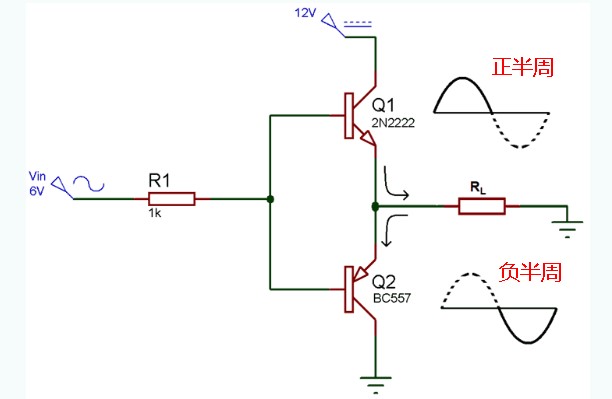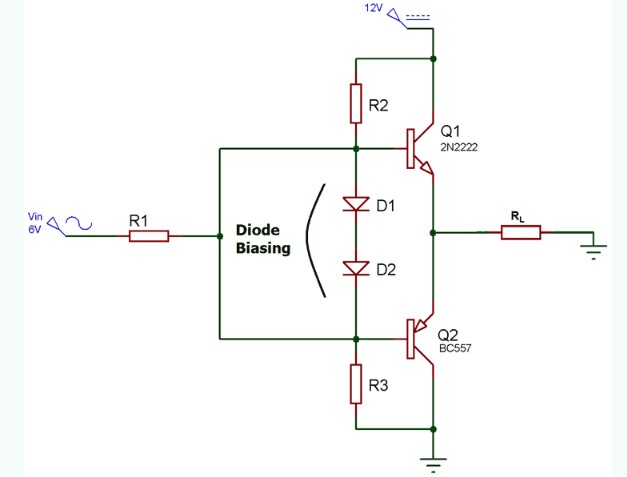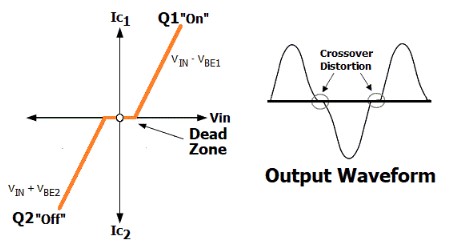推挽放大器的主要类型及工作原理
发布日期:2022-08-30
点击次数:1870
对长距离音频通信的需求增加时,就需要增加电信号的幅度以便远距离传输它们。早期虽然采用多种方式放大信号,但效果仍不尽如人意。大约在1912年,世界上第一次引入了放大器,也就是可以放大以增加输入信号功率的设备。
在早期的放大器中,真空管被使用,后来在1960年代被晶体管取代。基于用于设计它们的有源电路及功能操作等,目前有许多类型的放大器,其中就包括增加负载可用功率的功率放大器,而推挽式放大器是功率放大器之一。
什么是推挽放大器
推挽放大器是一种功率放大器,用于为负载提供大功率。它由两个晶体管组成,一个是NPN,另一个是PNP。其中一个晶体管在正半周期推动输出,而另一个在负半周期推动输出。简单来说就是,一个晶体管将电流推向一个方向,而另一个晶体管将电流拉向另一个方向,这就是它被称为推挽放大器的原因。
这些放大器比单端A类放大器效率更高。由于推挽放大器中的晶体管是反相的,所以这两个晶体管的输出之间的差异被提供给负载。信号中存在的偶次谐波被消除。这种方法减少了由于非线性分量而出现在信号中的失真。
主要类型
推挽放大器主要分为三类,但一般B类放大器被默认为是推挽放大器。
A类推挽放大器
B类推挽放大器
AB类推挽放大器
下面将依次介绍下这三种类型的电路,需要的材料如下:
变压器 (6-0-6)
BC557-PNP晶体管
2N2222-NPN晶体管
电阻器 – 1k(2 个)
LED
1、A类推挽放大器
A类是最常见的功率放大器配置,它仅由一个设置为始终保持开启的开关晶体管组成,产生输出信号的最小失真和最大幅度。A类推挽放大器的效率非常低,接近30%。即使没有连接输入信号,A类推挽放大器的级也允许相同数量的负载电流流过它,因此输出晶体管需要大型散热器。A类推挽放大器的电路图如下:


2、B类推挽放大器
B类推挽放大器是实际的推挽放大器。B类推挽放大器的效率高于A类,可达到78.9%,因为它由两个晶体管NPN和PNP组成。B类推挽放大器电路以这样一种方式偏置,即每个晶体管将在输入波形的半个周期上工作。因此,这类放大电路的导通角为180度。一个晶体管在正半周期推动输出,而另一个在负半周期推动输出。B类推挽放大器的电路图如下:

另外,B类通常会受到称为交叉失真的影响,其中信号在0V时会失真。众所周知,晶体管的基极-发射极结需要0.7v的电压才能打开。因此,当交流输入电压施加到推挽放大器时,它从0开始增加,直到达到0.7v,晶体管保持在关闭状态,没有得到任何输出。PNP晶体管在交流波的负半周也会发生同样的事情,这被称为死区。为了克服这个问题,二极管用于偏置,然后放大器被称为AB类放大器。
3、AB类推挽放大器
消除B类放大器中交叉失真的常用方法是将两个晶体管偏置在略高于晶体管截止点的点。那么这个电路被称为AB类放大器挽放电路,其电路图如下所示:

可以看出,AB类放大器挽放电路实际上上A类和B类放大器的组合。通过添加二极管,即使在基极端没有信号的情况下,晶体管也被偏置在轻微的导通状态,从而消除了交叉失真问题。
工作原理
推挽放大电路原理图由两个晶体管Q1和Q2组成,分别为NPN和PNP。当输入信号为正时,Q1开始导通并在输出端产生正输入的副本。此时Q2仍处于关闭状态。
在这种情况下,V OUT = V IN – V BE1。
同样,当输入信号为负时,Q1关闭,Q2开始导通,并在输出端产生负输入的副本。
在这种情况下,V OUT = V IN + V BE2。
现在为什么当V IN达到零时会发生交叉失真?可以看看下面显示的推挽放大器电路的粗略特性图和输出波形。


可以看出,晶体管Q1和Q2不能同时导通,要使Q1导通,要求 V IN必须大于V out,对于Q2,V IN必须小于 V out。如果V IN等于0,则Vout也必须等于0。
现在,当V IN从零开始增加时,输出电压Vout将保持为零,直到V IN小于V BE1(约为0.7v),其中V BE是开启 NPN晶体管 Q1所需的电压。因此,在 V IN小于V BE或0.7v期间,输出电压呈现死区(Dead Zone)。当V IN从零减小时也会发生同样的情况,PNP晶体管Q2直到V IN大于V BE2 (~0.7v) 才会导通,其中V BE2是开启晶体管Q2所需的电压。
主要优势
推挽放大器的输出是两个晶体管的集电极电流之差,这消除了输出中的谐波。这种方法还可以减少失真。B类推挽放大器效率高,可以在有限的电源条件下工作,而且B类放大器推挽电路简单,输出不包含偶次谐波。AB类放大器推挽电路降低了交叉失真。所以,推挽放大器的优点是当信号不存在时,输出晶体管中没有功率耗散。
主要应用
推挽式放大器的一些主要应用如下:
用于射频系统。
在数字系统中,使用这些放大器是因为它们成本低且设计更小。
用于电视、手机、电脑的音频放大。
在需要低失真的长距离通信系统中,使用这些放大器。
这些与扬声器一起使用。
用于放大射频信号。
在电力电子系统中使用推挽放大器。
总结
推挽放大器就是在电路中有两个晶体管,其中一个晶体管在输入信号的正半周期间将电流推向输出端,而另一个晶体管在输入信号的负半周期间将电流拉向输出端。
需要注意的是,除了晶体管,真空管也被用作这些放大器中的有源元件,而如今变压器很少用于放大器的输出级。在对称推挽中,每个输出对相互镜像,也就是一半的NPN与另一半的PNP镜像。同样,根据输出电路的不同,还有准对称、超对称、平方律推挽。
|
免责声明: 本文章转自其它平台,并不代表本站观点及立场。若有侵权或异议,请联系我们删除。谢谢! |











